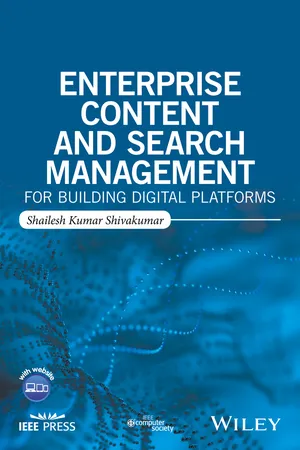
Enterprise Content and Search Management for Building Digital Platforms
- English
- ePUB (mobile friendly)
- Available on iOS & Android
Enterprise Content and Search Management for Building Digital Platforms
About This Book
Provides modern enterprises with the tools to create a robust digital platform utilizing proven best practices, practical models, and time-tested techniques
Contemporary business organizations can either embrace the digital revolution—or be left behind. Enterprise Content and Search Management for Building Digital Platforms provides modern enterprises with the necessary tools to create a robust digital platform utilizing proven best practices, practical models, and time-tested techniques to compete in the today's digital world. Features include comprehensive discussions on content strategy, content key performance indicators (KPIs), mobile-first strategy, content assessment models, various practical techniques and methodologies successfully used in real-world digital programs, relevant case studies, and more. Initial chapters cover core concepts of a content management system (CMS), including content strategy; CMS architecture, templates, and workflow; reference architectures, information architecture, taxonomy, and content metadata. Advanced CMS topics are then covered, with chapters on integration, content standards, digital asset management (DAM), document management, and content migration, evaluation, validation, maintenance, analytics, SEO, security, infrastructure, and performance. The basics of enterprise search technologies are explored next, and address enterprise search architecture, advanced search, operations, and governance. Final chapters then focus on enterprise program management and feature coverage of various concepts of digital program management and best practices—along with an illuminating end-to-end digital program case study.
- Offers a comprehensive guide to the understanding and learning of new methodologies, techniques, and models for the creation of an end-to-end digital system
- Addresses a wide variety of proven best practices and deployed techniques in content management and enterprise search space which can be readily used for digital programs
- Covers the latest digital trends such as mobile-first strategy, responsive design, adaptive content design, micro services architecture, semantic search and such and also utilizes sample reference architecture for implementing solutions
- Features numerous case studies to enhance comprehension, including a complete end-to-end digital program case study
- Provides readily usable content management checklists and templates for defining content strategy, CMS evaluation, search evaluation and DAM evaluation
Comprehensive and cutting-edge, Enterprise Content and Search Management for Building Digital Platforms is an invaluable reference resource for creating an optimal enterprise digital eco-system to meet the challenges of today's hyper-connected world.
Frequently asked questions
Information
Part 1
Content Management Basics for Digital Platforms
Chapter 1
Introduction to Digital Platforms
1.1 Enterprise Digital Ecosystem
Digital Opportunities for Enterprises
- Provide consistent Omni-channel experience to provide content anytime, anywhere, on any device.
- Enhance information discovery process and provide personalized and relevant information for a given context.
- Leverage social exchange and collaboration to engage, collaborate, and influence customer behavior. Monitoring and listening to social conversations helps in better branding, improved product quality management, and for achieving effective customer service.
- Gather real-time insights into customer behavior through analytics. Customer behavior, navigations, actions, purchase patterns can be used for enhancing and personalizing user experience.
- Provide contextual, personalized content and recommendations to drive customer's decision making.
- Leverage data from all customer interactions to provide highly engaging customer support and user experience. Move from transactional model to long lasting relationship model with customers.
- Provide unified and consolidated view of customer to design better marketing campaigns and sale offers, loyalty offers, and personalized promotions.
- Enable a self-service model across various customer interaction points and optimized operations.
- Convert the site traffic into sales through personalized and engaging experiences.
- Enhance productivity of the workforce through self-service tools and simplified processes and productivity-enhancing tools and accelerators.
- Streamline platform support, maintenance, and operations through intuitive dashboard-based real-time monitoring. Adopt agile delivery model to shorten the time to market.
- Provide “on the go” and on-demand services and optimize the infrastructure cost through ...
Table of contents
- Cover
- Title Page
- Copyright
- Preface
- Acknowledgments
- About the Author
- About the Companion Website
- Part 1: Content Management Basics for Digital Platforms
- Part 2: Advanced Content Management
- Part 3: Enterprise Search Technologies 375
- Further Reading
- Index
- Wiley End User License Agreement